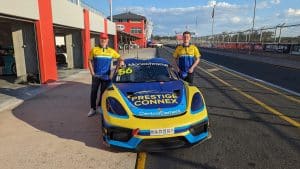On the weekend I was fortunate enough to have my first experience of commentating speedway racing, thanks to Legend Cars Australia. I called the popular motorcycle-powered vehicles in action at two popular speedway venues – Simpson Speedway on Saturday night, and Premier Speedway Warrnambool on Sunday night.
These venues are based in a regional area in southern Victoria but both nights managed to draw strong crowds, despite other major events in the area (including a folk festival at Port Fairy) and (on Saturday) gradually-worsening weather conditions.
I loved the experience. As someone who has spent more than a decade calling circuit racing, speedway commentary was a whole new world. In circuit racing, there are sometimes – often, even – lull periods where not a lot of action is actually happening, and you have to be prepared to add analytical comments about the drivers, cars, strategy etc. to fill the air time.
This is not something you need to worry about in speedway commentary! The action is non-stop from start to finish unless there’s a caution or red-flag interruption. The only problem is that just as I was starting to really enjoy myself, it was all over… I guess that means I’ll have to do some more speedway work then!
Having reflected on the last two evenings, I’ve decided that – in terms of putting on a show and thus drawing a crowd – the circuit racing fraternity could do a lot worse than to look at how speedway events are run. I’m not saying circuit racing and speedway need to become exactly the same, but here are three specific points worth further discussion:
Fast cars don’t always start at the front
The circuit racing industry seems to have become fixated on how to increase overtaking and passing. And yet, we all keep missing an obvious point – thanks to qualifying, the faster cars always start ahead of slower cars on the grid, which completely goes against the objective of creating more overtaking.
Since 2009, the Virgin Australia Supercars Championship has gone even further down this path by having qualifying for every single race. At least with the previous progressive grid format, there was a chance that a top-line driver might have a bad start to the weekend and then entertain fans with a charge back to the front, but that no longer happens.
In speedway, there is often no qualifying at all; grid positions for the heats are determined randomly. Yes, the grid spots for the final or A-main are determined based on heat points, but in the heats there is guaranteed to be plenty of passing. And the fans love it! Why can’t we do something like this in circuit racing?
Night racing
Most circuit racing events require at least a full day, or even a weekend, to gain full value from the spectating experience. It’s often not practical for people to spend a full day at any sort of sporting event.
By comparison, an average speedway evening starts at 6pm and is over by 10 or 10:30. It requires a lot less of a lifestyle sacrifice to enjoy a speedway event, and crowd numbers tell the story, just like they do for the ever-expanding T20 Big Bash League in cricket which adheres to a similar timeslot.
The introduction of night racing for the Supercars at Hidden Valley starting in 2018 is an encouraging indication that the circuit racing community is paying attention.
Always something happening
I went to the Formula 1 Grand Prix at Abu Dhabi in 2013. I watched a GP3 race… waited an hour… watched a GP2 race… waited an hour… watched a Porsche Supercup race……………………………………………………………………………………………………. waited more than two hours……………………………………………………………………………………………………. and finally watched the Grand Prix.
With no public access to the pits, I didn’t have a lot to do in the intervening periods of non-action except surf social media on my phone (and because of the time-zone difference, most of my friends in Australia were asleep so it was hardly an enlightening activity).
This is obviously an extreme example but the point is, people go to a racetrack to watch racing, so give them racing to watch!
Speedway has this nailed. Barely a minute passes after one race finishes, before another group of cars are gridding up for the next heat.
Supercars could learn from this, Formula 1 even more so.
A side note – there was no public access to the pits at either of the speedways I attended until the racing finished… but to be honest, the spectators were so captivated by the on-track activity they were happy to wait until the end of the evening anyway.




